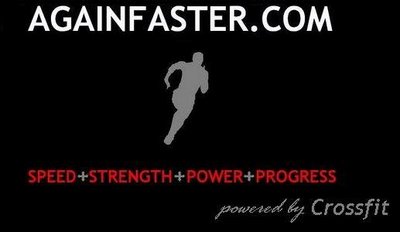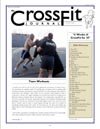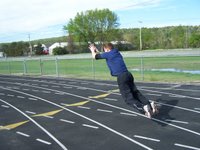Leverage

Today, I did a full-out, honest-to-God back lever.
I was psyched. Successfully performing a back lever requires full-body muscular tension, starting in the core and radiating through the limbs. Developing this tension is a function of recruitment.
As we train, we learn to effectively use a greater portion of our existing muscle mass, recruiting more muscle fiber into action. The vast majority of trainees can add strength and power without adding an ounce of additional muscle by learning effective muscle recruitment.
Our basic exercises are full-body movements. The squat, the pushup, the pullup, and the handstand pushup all require bodily involvement from the toes to the top of the head. To paraphrase Dan John: If you don't think the pushup is a full-body movement, have your training partner poke you in the ankle with a fork next time you're doing a pushup. I bet you won't complete the rep, despite the "lack" of lower body involvement.
To generate tension and additional strength in the legs, start at the toes. Use them to grip the floor. This is very similar to making a fist with your hand. I first learned this technique as a martial arts student and instructor during the late 1980s, and was reintroduced to it by Mandla Nkosi in the course of our kettlebell training.
Gripping the floor, combined with a slight outward rotation of the knees, will create tension in the calves, quads, hamstrings, glutes, adductors, and abductors. This tension will make squat variations, cleans, snatches, and deadlifts much easier.
To generate tension throughout the torso, take a deep breath and hold it prior to the concentric muscle movement. This will establish a natural belt around the abdomen and allow you to control a greater load. On the eccentric movement, go through your sticking point, and slowly release the breath. If you release too quickly, you'll fall victim to a whole lot of iron plummeting to earth. Don't do this. A properly tensioned torso is critical to nearly every movement I can think of, from squats to heavy overhead presses.
Generating tension in the arms and back involves complementary movements. If you're working with weight, grip the handle as tightly as you can. Squeeze the life out of the bar. This will cause tension in the forearms, bicep, tricep, and throughout the shoulder girdle. Now, pull the shoulders down into the socket. This will cause the lats to fire and the shoulder girdle to tighten further. Properly engaging the back will connect your torso and legs, making you one effective piece.
The hardest part--relax your face. There's no point in looking like a high-colonic victim if you can avoid it. Despite the tension throughout your body, try to maintain a tranquil mindset. This starts with a relaxed face.
Try these methods, and find what works for you. Tinker with your breathing and body position to find the combinations that produce the most tension.
Be sure to maintain proper form throughout any and every movement.
Practice creating tension in all your movements, even when it's seemingly unnecessary. This will give you greater body awareness, and the ability to recruit muscles at will. Recently, I've had quite a bit of trouble recruiting my lats during pressing movements. I'm remedying this problem by pulling the shoulders down and teaching my brain what the flexed lat should feel like during a press.
A good coach is invaluable in diagnosing and treating muscle recruitment problems. In my case, Neal Thompson has been a savior.
The ability to generate tension will make you globally stronger. You'll make bigger lifts without spending significant time on mass building efforts.
Three-by-three rep schemes and working one-rep maxes will aid your recruitment skills, because they require significant tension generation for any amount of success. As you practice the heavier lifts (deadlift, squat variations, clean and jerk), you'll find new ways to generate strength from your existing muscle base. Tension will become second nature.
If you'd like to work on tension generation or any other skill in person, just drop me a line. I'm happy to help. Mandla is a veritable expert on the topic--you can contact him via his website or through me.
Go faster!
Picture from the back lever tutorial on beastskills.com. There is a lot of great information on performing various gymnastic skills at this site--check it out.

Today, I did a full-out, honest-to-God back lever.
I was psyched. Successfully performing a back lever requires full-body muscular tension, starting in the core and radiating through the limbs. Developing this tension is a function of recruitment.
As we train, we learn to effectively use a greater portion of our existing muscle mass, recruiting more muscle fiber into action. The vast majority of trainees can add strength and power without adding an ounce of additional muscle by learning effective muscle recruitment.
Our basic exercises are full-body movements. The squat, the pushup, the pullup, and the handstand pushup all require bodily involvement from the toes to the top of the head. To paraphrase Dan John: If you don't think the pushup is a full-body movement, have your training partner poke you in the ankle with a fork next time you're doing a pushup. I bet you won't complete the rep, despite the "lack" of lower body involvement.
To generate tension and additional strength in the legs, start at the toes. Use them to grip the floor. This is very similar to making a fist with your hand. I first learned this technique as a martial arts student and instructor during the late 1980s, and was reintroduced to it by Mandla Nkosi in the course of our kettlebell training.
Gripping the floor, combined with a slight outward rotation of the knees, will create tension in the calves, quads, hamstrings, glutes, adductors, and abductors. This tension will make squat variations, cleans, snatches, and deadlifts much easier.
To generate tension throughout the torso, take a deep breath and hold it prior to the concentric muscle movement. This will establish a natural belt around the abdomen and allow you to control a greater load. On the eccentric movement, go through your sticking point, and slowly release the breath. If you release too quickly, you'll fall victim to a whole lot of iron plummeting to earth. Don't do this. A properly tensioned torso is critical to nearly every movement I can think of, from squats to heavy overhead presses.
Generating tension in the arms and back involves complementary movements. If you're working with weight, grip the handle as tightly as you can. Squeeze the life out of the bar. This will cause tension in the forearms, bicep, tricep, and throughout the shoulder girdle. Now, pull the shoulders down into the socket. This will cause the lats to fire and the shoulder girdle to tighten further. Properly engaging the back will connect your torso and legs, making you one effective piece.
The hardest part--relax your face. There's no point in looking like a high-colonic victim if you can avoid it. Despite the tension throughout your body, try to maintain a tranquil mindset. This starts with a relaxed face.
Try these methods, and find what works for you. Tinker with your breathing and body position to find the combinations that produce the most tension.
Be sure to maintain proper form throughout any and every movement.
Practice creating tension in all your movements, even when it's seemingly unnecessary. This will give you greater body awareness, and the ability to recruit muscles at will. Recently, I've had quite a bit of trouble recruiting my lats during pressing movements. I'm remedying this problem by pulling the shoulders down and teaching my brain what the flexed lat should feel like during a press.
A good coach is invaluable in diagnosing and treating muscle recruitment problems. In my case, Neal Thompson has been a savior.
The ability to generate tension will make you globally stronger. You'll make bigger lifts without spending significant time on mass building efforts.
Three-by-three rep schemes and working one-rep maxes will aid your recruitment skills, because they require significant tension generation for any amount of success. As you practice the heavier lifts (deadlift, squat variations, clean and jerk), you'll find new ways to generate strength from your existing muscle base. Tension will become second nature.
If you'd like to work on tension generation or any other skill in person, just drop me a line. I'm happy to help. Mandla is a veritable expert on the topic--you can contact him via his website or through me.
Go faster!
Picture from the back lever tutorial on beastskills.com. There is a lot of great information on performing various gymnastic skills at this site--check it out.




















6 Comments:
Great article, Jon. How long were you practicing and what's next?
Toby
Hey guys,
I've enabled a feature on the website called comment moderation. When you post, your comments won't appear on the site immediately. Not to worry--they'll be up shortly thereafter.
Please continue to post as you usually would. Thanks for all the support!
Toby,
According to Beast Skills, the back lever is merely a level A move. Gymnastics skills are rated A through E, with A being the easiest. The muscleup is also included in this category.
I'd really like to get a muscleup--it's eluded me so far. After that, who knows?
I think we need to spend more time doing ring work. Perhaps next Sunday...
a muscle up and back lever are only As?! What are Es?
Sam
Tara,
I'll try it on the bar and let you know how it goes...
Sammy,
I looked all over the place. Evidently, skill ratings are contained in the FIG Table of Elements, which doesn't seem to exist anywhere on the web. I did find some interesting stuff at USA Gymnastics, including a tutorial on ring handstands!
I've tried them--they're scary.
USA Gymnastics
Tara,
This is the closest I came to horizontal. It's much harder on the bar...
Picture
Post a Comment
<< Home